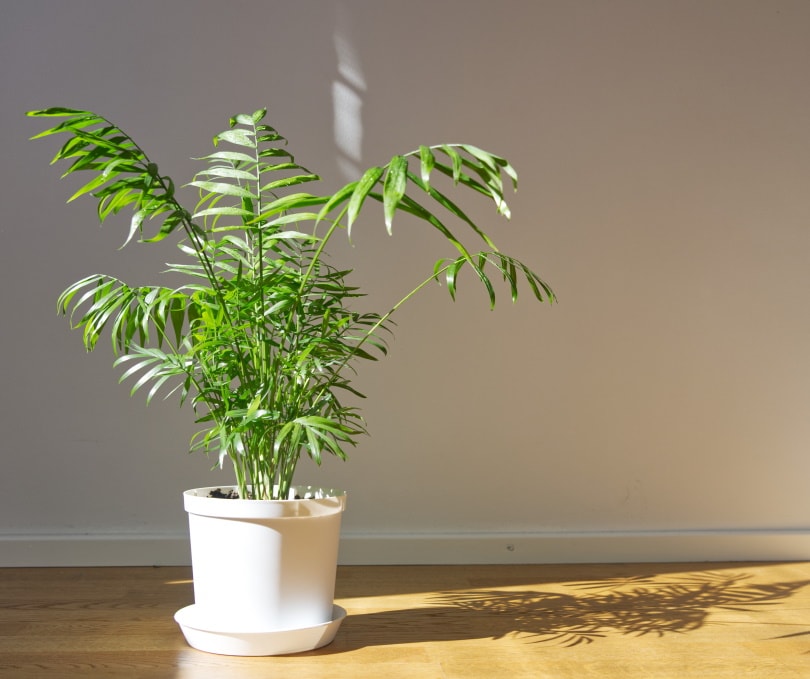How Much and How Often to Water Palm Plant
-
Pete Ortiz
- Last updated:

The palm plant is a beautiful and popular addition to any home. But like any plant, it needs the right amount of water to stay healthy. Over-watering can lead to problems such as root rot, while under-watering can cause the leaves to turn brown and drop off. So, how much and how often should you water your palm plant?
Palm Plant Watering Guidelines

It’s best to water your palm plant once a week. This gives the plant time to absorb the water. If the leaves start to turn brown or drop off, you may need to increase the frequency of watering.
When it comes to how much water to use, it is important not to overwater. Check the soil before watering, and only add enough water to moisten the top inch or so of soil. Too much water can lead to problems such as root rot.
If you are unsure how often to water your palm plant, it is best to err on the side of caution and water less frequently rather than more. You can always increase the frequency if necessary.
Before you water, check the pot for drainage holes. If there are none, drill a few holes in the bottom of the pot. Fill a container with lukewarm water. Place the pot in the sink and slowly add water until it begins to drip out of the holes. Do not water again until the top inch of the soil is dry to the touch. When you do water, make sure to empty any excess water from the saucer so that your plant isn’t sitting in soggy soil.
- Check the Soil – The best way to check the soil is to stick your finger into it. If it feels dry several inches below the surface, it’s time to water.
- Another method is to lift the pot and feel its weight. A pot that’s light because the soil is dry will need water. A pot that’s heavy because the soil is wet does not need water.
- Do Not Overwater – It’s important not to overwater a palm plant. Remember, the roots can rot if they sit in water for too long. If the leaves turn yellow, this is a sign of overwatering. Let the soil dry out completely before watering again.
- Use Room-Temperature Water – Use room-temperature water when watering your palm plant. Cold water can shock the roots and damage the leaves.
- Watering Needs Vary by Season – During the hot summer months, water your palms once or twice per week, allowing the top few inches of soil to dry out between waterings. In cooler winter months, reduce watering to once every two weeks or less, depending on rainfall. Check the soil around each palm before watering to ensure it’s dry to a depth of 4 inches.
- Fertilize Carefully – Fertilize your palms with a high-quality, slow-release palm fertilizer. Some fertilizers are good for several months, while others require more frequent use. In general, though, you should only need to fertilize between one and three times a year. Apply the fertilizer according to package directions around the drip line of each palm. Water deeply after applying fertilizer to help distribute nutrients throughout the root zone.
- Monitor Your Plant – The first step to knowing how much and how often to water your palm plant is to monitor it. Keep an eye on the leaves and fronds. If they are wilting, drooping, or turning brown, that’s a sign that your plant needs more water. On the other hand, if the leaves are yellowing, that’s a sign of too much water.
Care Tips for Palm Plants

If you want your palm plant to thrive, there are a few things you need to do. First, make sure that you choose the right type of palm plant for your climate. There are many different types of palm plants, and not all of them will do well in every climate.
Once you’ve chosen the right type of palm plant, you’ll need to provide it with the proper care. Here are a few tips to help you take care of your palm plant:
Water your palm plant regularly. Palm plants like to be kept moist but not soggy. Be sure to check the soil before watering, and only water when the top inch or so of soil is dry.
Give your palm plant plenty of light. Most palm plants prefer bright, indirect sunlight. If you live in a particularly hot climate, you may need to provide some afternoon shade to prevent leaf burn.
Be sure to keep an eye out for pests. Common pests that attack palm plants include scale insects, spider mites, and mealybugs. If you see any pests on your plant, be sure to treat them immediately.
Pruning and trimming the palm plant is essential to its health and growth. Always cut away any dead or yellow leaves, as well as any fronds that are crossing over or rubbing against each other. These can create weak points that invite disease or pests.
When pruning, be sure to use clean, sharp shears or a knife to avoid damaging the plant. You should only need to prune your palm plant a couple of times a year.
Conclusion
Palm plants are generally very low-maintenance, but they do require some basic care to stay healthy and thrive. Follow the tips outlined above, and you can be sure to have a beautiful, healthy palm plant that will bring life and energy to your home or office for years to come.
See also:
Featured Image Credit: Beekeepx, Shutterstock


